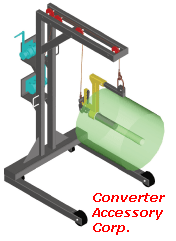Need a Hand?
- Published: November 30, 2005, By Carrie Cleaveland, Assistant Editor
Product Focus
Improper roll handling boils down to one thing: loss. Lost workers, lost productivity, and lost money. In addition to damaged rolls and materials, employee safety is a major risk when rolls are handled manually. Consider roll handling equipment. Your workers—and your company’s bottom line—will thank you.
Things To Consider
- Efficiency of equipment. Some applications require roll handling equipment to be faster or slower than what’s available. You have to analyze how fast you need to move and turn rolls. When we talk about roll handling equipment, we talk about two facets of roll handling: moving rolls around your plant and turning rolls (generally people have to turn rolls 90 deg) from horizontal to perpendicular. The question is how fast do you need to do that? Do you need to get a roll from Point A to Point B and turn it in a minute, or do you have a half-hour to do it? You want to think about how efficient the equipment is and how fast you actually need to do it.
- Ease of Use. The operator might not want to use the equipment because it’s heavier and harder to handle than just picking up the roll.
- Get everyone involved. From the plant engineer to the guys on the floor, try to get as many people involved in the process as possible. A lot of times you’ll see roll handling equipment on the floor, tucked off in a corner somewhere that nobody’s using because the operator wasn’t included in the decision-making process.
- —Jeff Damour, president, Converter Accessory Corp. (CAC), Wind Gap, PA (converteraccessory.com)
Safety First
- The safety initiative is paramount for reducing insurance claims and costs. Worker safety requires constant monitoring of product-handling techniques. The result can be a dramatic reduction in workers’ compensation claims, lost time, and restricted duty records due to injury. The first step to improving ergonomic conditions by minimizing the manual material handling of rolls: Surveying average roll sizes and weights, core diameters, handling elevations, pallet heights, and the rate of throughput.
- For example, workers’ compensation claims at one company were averaging $13,000 each, not including lost time and reduced productivity hitting the bottom line. The company was handling large master rolls weighing up to 1,500 lbs. The rolls were slit down to smaller rolls weighing from 75–100 lbs each. These smaller rolls traditionally had been packed by hand. In a single work shift, two employees would handle an average of 12,000 lbs of rolls. A department safety survey led to a handling system for both small and large rolls that ended the need for walking, carrying, or heavy lifting. There have not been any major lifting injuries reported at the packaging firm since the system was installed several years ago.
- —Jerry Morton, general manager, Tilt-Lock, St. Michael, MN (tiltlock.com)
Living in a Material World
- There are a couple of ways to handle the rolls of material, and it depends primarily on the material. Some people handle the rolls by the material itself, by its body. That’s a convenient way to do it. The drawbacks are that you can damage the material, and as the diameter of the roll of material varies, so does the ability to handle it properly.
- Other people handle it by the cores. The advantage is that you don’t touch the material when you handle it. Also, the cores always are of a fixed diameter, so the ability to interface it with the equipment properly is much easier. A disadvantage is that the cores have to be longer than the material itself, which becomes a problem if you ever need to stand a roll of material up on end.
- —Bob Pasquale, president, New Era Converting Machinery, Paterson, NJ (neweraconverting.com)

For this and other foil stamping new products, see our December New Products section.
Restrictions of time and space limit the number of companies, products, and trends that we can discuss in these reports. For additional information, see PFFC’s features and departments each month, consult the June Buyers Guide, and search our online archives.












